Neurology & Motor Skill Development
Cerebral Palsy (CP)
Cerebral Palsy (CP) is an umbrella term applied to a group of disorders that affect the central nervous system. CP results in physical deficits including muscle weakness, spasticity, increased coactivation and decreased voluntary motor control. These commonly lead to an increased likelihood of poor functional strength, impaired circulation, decreased endurance, lower bone mineral density, limitations to fine motor control and an increased risk of cardiorespiratory and digestive issues. These potential physical restrictions can inhibit people’s ability to perform activities of daily living autonomously and live independently. CP is a permanent condition acquired by an injury to the developing brain, symptoms do not generally worsen with time.
There are signs that a child may have CP. In babies, things like low muscle tone, feeling stiff or having muscle spasms, delayed development, feeding or swallowing difficulties. In toddlers not walking by 12-18 months and not speaking sentences by 24 months can be signs.
Treatments of resulting complications are very individual, medication and physical therapy being common among those with CP. As well as all the general benefits of exercise, appropriate prescription can aid in such things as functional muscular strength and range, helping with cardiovascular health, and maintenance of bone mineral density for those with CP.
There are signs that a child may have CP. In babies, things like low muscle tone, feeling stiff or having muscle spasms, delayed development, feeding or swallowing difficulties. In toddlers not walking by 12-18 months and not speaking sentences by 24 months can be signs.
Treatments of resulting complications are very individual, medication and physical therapy being common among those with CP. As well as all the general benefits of exercise, appropriate prescription can aid in such things as functional muscular strength and range, helping with cardiovascular health, and maintenance of bone mineral density for those with CP.
Duchenne Muscular Dystrophy (DMD)
DMD is a genetic condition resulting in progressive muscle weakness and degeneration. DMD primarily affects males, although can present in females as well. The condition appears in early childhood and early symptoms can include delays in developmental milestones such as sitting, standing, and walking. The progressive weakness can lead to impaired pulmonary and cardiac function and can eventually cause respiratory failure.
Exercise is recommended as part of a larger therapeutic plan. Exercise can aid in building muscular strength and can ease pain and discomfort from contractures. Dosage is very important as exercising to the point of exhaustion can cause harm. Hydrotherapy is highly recommended as damage is less likely due to the buoyancy of the water. All exercise should be prescribed by and performed under guidance from a health professional in liaison with a medical professional.
Exercise is recommended as part of a larger therapeutic plan. Exercise can aid in building muscular strength and can ease pain and discomfort from contractures. Dosage is very important as exercising to the point of exhaustion can cause harm. Hydrotherapy is highly recommended as damage is less likely due to the buoyancy of the water. All exercise should be prescribed by and performed under guidance from a health professional in liaison with a medical professional.
Multiple Sclerosis (MS)
MS is a central nervous system condition where lesions interfere with nerve impulses within the brain, spinal cord, and optic nerves. There are multiple variations of MS, including relapsing-remitting, secondary progressive, primary progressive and can range mild to severe. MS is commonly diagnosed between 20-40years of age, although can be diagnosed earlier or later in life as well. MS affects 2 million people worldwide, and nearly three times as many women as men.
Symptoms vary depending on where the lesions are, and MS will not present in the same way from person to person. Generally, symptoms can include a decline in motor control, increased fatigue, neurological symptoms, continence issues, and neuropsychological symptoms, or some combination of these.
Treatment usually consists of a combination of therapies. Drug therapy, with various medications being prescribed to help combat negative symptoms, Lifestyle factors including changes to diet and physical activity can also play a vital role in symptom management. Exercise benefits persons with MS in the same way it benefits everyone, improved muscular strength, balance, cardiovascular function, and metabolic health. It has also been shown to help with MS-related fatigue and management of spasticity.
Symptoms vary depending on where the lesions are, and MS will not present in the same way from person to person. Generally, symptoms can include a decline in motor control, increased fatigue, neurological symptoms, continence issues, and neuropsychological symptoms, or some combination of these.
Treatment usually consists of a combination of therapies. Drug therapy, with various medications being prescribed to help combat negative symptoms, Lifestyle factors including changes to diet and physical activity can also play a vital role in symptom management. Exercise benefits persons with MS in the same way it benefits everyone, improved muscular strength, balance, cardiovascular function, and metabolic health. It has also been shown to help with MS-related fatigue and management of spasticity.
Spinal Cord Injury (SCI)
The primary cause of SCI is trauma resulting in damage to the spinal cord, other causes include illness such as cancer and viral or bacterial infections. Various neurological, physiological, psychological, and social issues can arise following a SCI and no two persons will present with the same symptoms or require the exact same treatment. Globally the most affected population is males aged 18-32years. Following a SCI, a neurological assessment will be performed in the hospital, for example the American Spinal Cord Association (ASIA) classification system. The ASIA score is the standard used in Australian hospitals and this along with the injury level can provide guidance for predicting prognosis and optimal treatment.
Respiratory and cardiovascular function needs to be monitored frequently in those with SCI as serious secondary concerns can arise, especially in those with a high injury level (for example in the cervical vertebrae). Loss of sensation and function below the injury level is common in SCI, this may be due to damage to the spinal cord however, in some cases it may be a result of excess swelling or other complications following the trauma. There are various initial treatments, ranging from decompressive surgery to medication.
Exercise is an important part of treatment following initial stabilisation. Physical therapy in a hospital or similar medical setting allows people to learn how to function and transition to outpatient status. In a more chronic setting, correct exercise prescription can be used to help maintain or improve function and muscular strength and cardiovascular function, improve pain and depressive or other negative mental health symptoms. Other common goals include developing new hobbies and social opportunities and working on community integration. Exercise needs to be prescribed by an appropriately qualified professional as persons with SCI can have a range of complications that exercise can exacerbate.
Respiratory and cardiovascular function needs to be monitored frequently in those with SCI as serious secondary concerns can arise, especially in those with a high injury level (for example in the cervical vertebrae). Loss of sensation and function below the injury level is common in SCI, this may be due to damage to the spinal cord however, in some cases it may be a result of excess swelling or other complications following the trauma. There are various initial treatments, ranging from decompressive surgery to medication.
Exercise is an important part of treatment following initial stabilisation. Physical therapy in a hospital or similar medical setting allows people to learn how to function and transition to outpatient status. In a more chronic setting, correct exercise prescription can be used to help maintain or improve function and muscular strength and cardiovascular function, improve pain and depressive or other negative mental health symptoms. Other common goals include developing new hobbies and social opportunities and working on community integration. Exercise needs to be prescribed by an appropriately qualified professional as persons with SCI can have a range of complications that exercise can exacerbate.
Stroke
Stroke occurs when blood cannot get to your brain because of a blocked (ischaemic stroke) or burst blood vessel (haemorrhagic stroke), this leads to a lack of oxygen to the brain resulting in damage or death of brain cells. Stroke can occur at any age, but risk increases with age. Other risk factors include modifiable risks such as smoking, alcohol consumption, high cholesterol, high blood pressure, and obesity.
When we think about the common signs of a stroke, we can remember the F.A.S.T acronym.
F – Face (Is it drooping?)
A – Arms (Can they lift them?)
S – Speech (Is it slurred/ Can they understand you?)
T – Time (If positive signs of FAS calling 000 quickly is critical)
Stroke can lead to numerous deficits both physically and cognitively.
Mobility and physical function can be affected and after a stroke you may experience:
– Muscle weakness (paralysis or paresis – generally on one side)
– Coordination issues
– Changes to muscles (high or low tone)
– Balance issues
– Changes in sensation
– Swelling
– Fatigue
– Pain
– Contractures (Muscle shortening leading to joints being “fixed” in a position)
Exercise therapy post stroke is immensely important. Specifically prescribed exercise can improve functional strength, coordination, and balance. Exercise can improve ability to perform activities of daily living, reduce muscle tone, reduce risk of further strokes, improve overall general health and fitness.
When we think about the common signs of a stroke, we can remember the F.A.S.T acronym.
F – Face (Is it drooping?)
A – Arms (Can they lift them?)
S – Speech (Is it slurred/ Can they understand you?)
T – Time (If positive signs of FAS calling 000 quickly is critical)
Stroke can lead to numerous deficits both physically and cognitively.
Mobility and physical function can be affected and after a stroke you may experience:
– Muscle weakness (paralysis or paresis – generally on one side)
– Coordination issues
– Changes to muscles (high or low tone)
– Balance issues
– Changes in sensation
– Swelling
– Fatigue
– Pain
– Contractures (Muscle shortening leading to joints being “fixed” in a position)
Exercise therapy post stroke is immensely important. Specifically prescribed exercise can improve functional strength, coordination, and balance. Exercise can improve ability to perform activities of daily living, reduce muscle tone, reduce risk of further strokes, improve overall general health and fitness.






